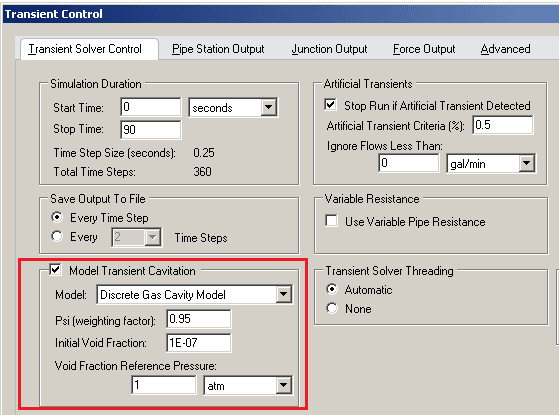AFT Blog
Benefits of the Discrete Gas Cavity Model
AFT Impulse 5 now includes a second cavitation model option: The Discrete Gas cavity Model (DGCM). So, what is it and how is it different from the existing cavitation model? This article will provide a very high level overview.
The method of characteristics (the finite difference basis for 1D transient flow modeling) assumes a constant wave speed for each pipe, from time step to time step. There are, however, many things that would cause a change in wave speed; cavitation being one the most significant. A change in wave speed will have a dramatic effect on the pressure spike that occurs when a gas or vapor cavity collapses. The existing cavitation model (the Discrete Vapor Cavity Model), will identify the existence of vapor cavitation and assume a fixed pressure (vapor pressure) at the affected computing station. The trouble with a fixed pressure computing station is that pressure waves cannot propagate through them, until the void collapses.
The DGCM assumes a small gas void at all computing stations, all the time. The DGCM does not switch between cavity existence and non-existence , as is the case with the vapor cavity model. Instead the DGCM cavity is continuously varying in size, according to the pressure (using the ideal gas law). The continuous variation of cavity volume allows the DGCM to mimic the behavior of variable wave speed by introducing what is essentially a small gas spring at every computing station. The effect of a continuously varying gas volume is twofold:
First, pressure waves can propagate through a computing station in the presence of cavitation
Second, the evolution significant cavity formation and collapse is more progressive
The bottom line: Impulse 4 models, that experience significant cavitation and show large unrealistic pressure spikes, may show much more stable and realistic results in Impulse 5, when using the Discrete Gas Cavity Model. It’s always a good idea to test problematic models using both the Vapor Cavity Model and the Gas Cavity Model to see if there is a difference.
The Discrete Gas Cavity Model can be enabled in the Transient Control window. The default values for Psi, Initial Void fraction, and Void Fraction Reference Pressure, work well in the vast majority of cases.




Comments 2
what is actually meaning of this statement
***CRITICAL WARNING*** The following pipes have vapor volumes in computing stations greater than 100% of the liquid computing volume
Hi Aqeel,
AFT Impulse allows vapor cavity sizes to grow and shrink as is dictated by the system hydraulics, meaning that there is no limit to the volume of vapor that can exist at any given computing station if the low pressures persist there. The warning you have reported indicates that it is exactly this phenomenon that is occurring. AFT Impulse issues a general warning when this vapor volume exceeds 10% of the computing station volume, and again a more serious warning when it exceeds 100% of the computing station volume (an event that is clearly physically impossible, but helpful nonetheless as it is indicative of the extent of the cavitation in that computing station). These warnings should always call attention to the analyzing engineer, but they do not necessarily indicate that the results are unreliable.